HND Business Unit 12: Organizational Behavior Report - LG Analysis
VerifiedAdded on 2023/01/18
|11
|3157
|29
Report
AI Summary
This report delves into the realm of organizational behavior, utilizing LG Corporation as a case study to illustrate key concepts. It examines how organizational culture, politics, and power dynamics influence individual and team behavior, referencing the Handy culture model and various political models. The report then evaluates content and process theories of motivation, including Maslow's hierarchy of needs and Adam's equity theory, and explores motivational techniques. Furthermore, it differentiates between effective and ineffective teams, outlining the characteristics that contribute to team success, such as communication, feedback, and learning opportunities, as opposed to those that hinder it. Finally, the report applies these concepts and philosophies of organizational behavior, offering insights into practical applications within a business context, making it a valuable resource for students studying leadership and management.
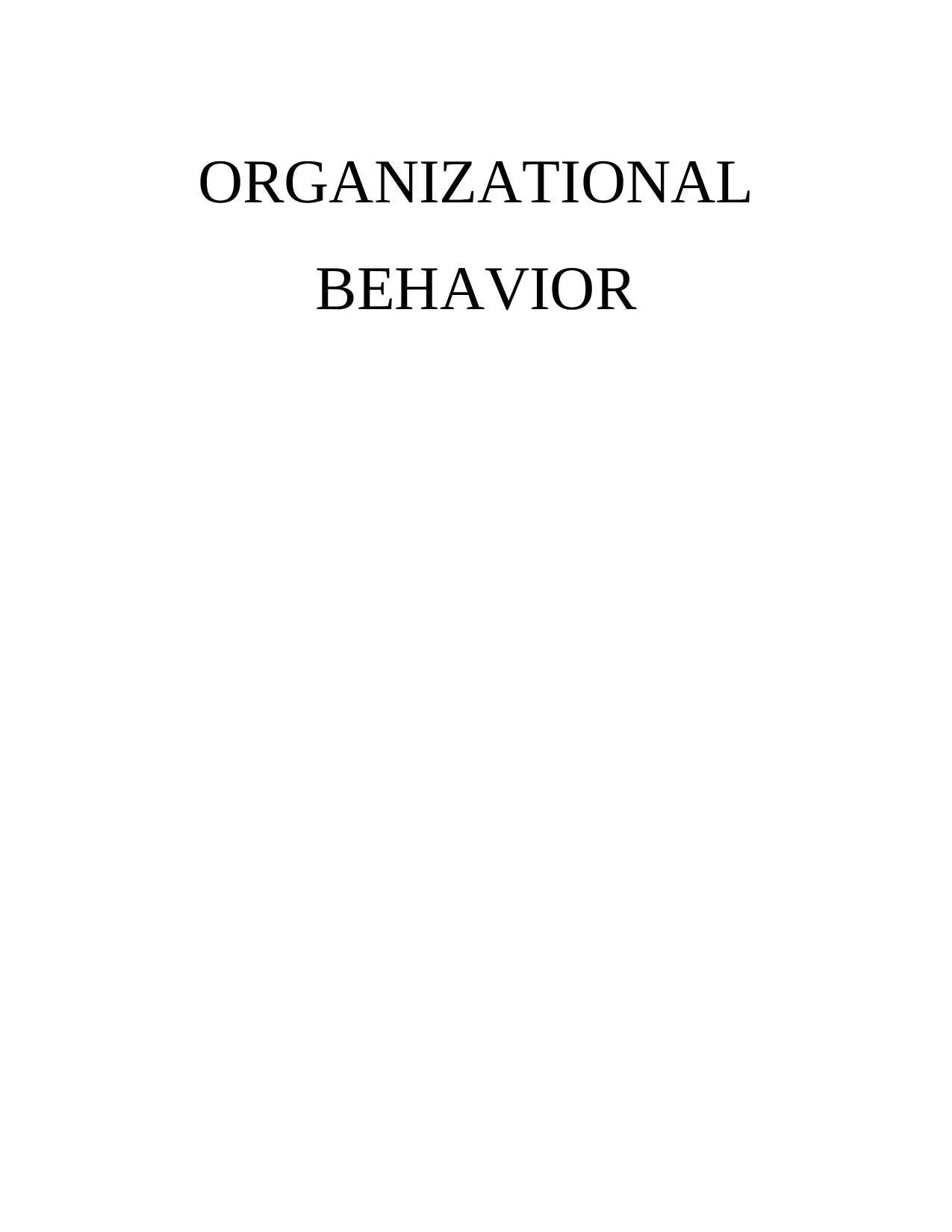
ORGANIZATIONAL
BEHAVIOR
BEHAVIOR
Paraphrase This Document
Need a fresh take? Get an instant paraphrase of this document with our AI Paraphraser
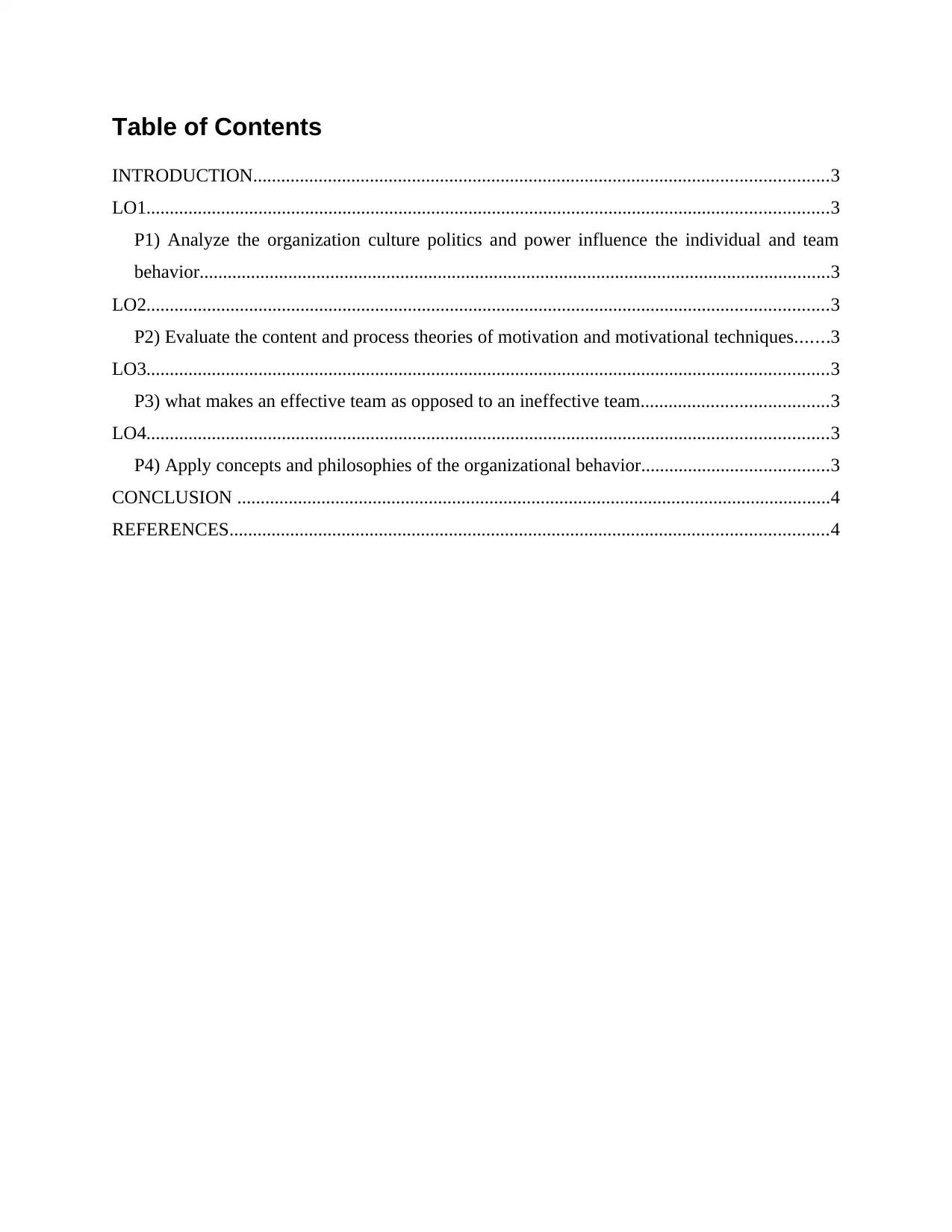
Table of Contents
INTRODUCTION...........................................................................................................................3
LO1..................................................................................................................................................3
P1) Analyze the organization culture politics and power influence the individual and team
behavior.......................................................................................................................................3
LO2..................................................................................................................................................3
P2) Evaluate the content and process theories of motivation and motivational techniques.......3
LO3..................................................................................................................................................3
P3) what makes an effective team as opposed to an ineffective team........................................3
LO4..................................................................................................................................................3
P4) Apply concepts and philosophies of the organizational behavior........................................3
CONCLUSION ...............................................................................................................................4
REFERENCES................................................................................................................................4
INTRODUCTION...........................................................................................................................3
LO1..................................................................................................................................................3
P1) Analyze the organization culture politics and power influence the individual and team
behavior.......................................................................................................................................3
LO2..................................................................................................................................................3
P2) Evaluate the content and process theories of motivation and motivational techniques.......3
LO3..................................................................................................................................................3
P3) what makes an effective team as opposed to an ineffective team........................................3
LO4..................................................................................................................................................3
P4) Apply concepts and philosophies of the organizational behavior........................................3
CONCLUSION ...............................................................................................................................4
REFERENCES................................................................................................................................4
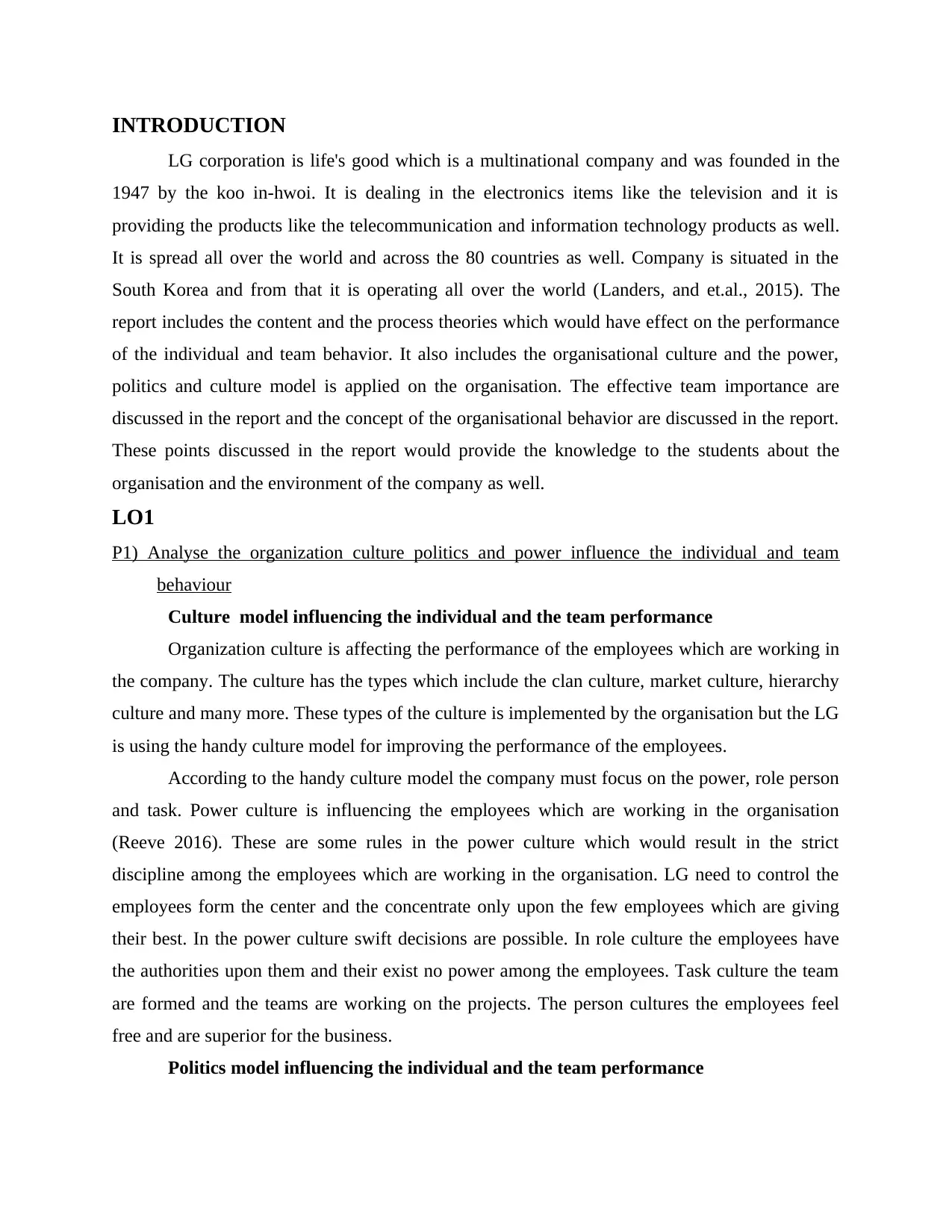
INTRODUCTION
LG corporation is life's good which is a multinational company and was founded in the
1947 by the koo in-hwoi. It is dealing in the electronics items like the television and it is
providing the products like the telecommunication and information technology products as well.
It is spread all over the world and across the 80 countries as well. Company is situated in the
South Korea and from that it is operating all over the world (Landers, and et.al., 2015). The
report includes the content and the process theories which would have effect on the performance
of the individual and team behavior. It also includes the organisational culture and the power,
politics and culture model is applied on the organisation. The effective team importance are
discussed in the report and the concept of the organisational behavior are discussed in the report.
These points discussed in the report would provide the knowledge to the students about the
organisation and the environment of the company as well.
LO1
P1) Analyse the organization culture politics and power influence the individual and team
behaviour
Culture model influencing the individual and the team performance
Organization culture is affecting the performance of the employees which are working in
the company. The culture has the types which include the clan culture, market culture, hierarchy
culture and many more. These types of the culture is implemented by the organisation but the LG
is using the handy culture model for improving the performance of the employees.
According to the handy culture model the company must focus on the power, role person
and task. Power culture is influencing the employees which are working in the organisation
(Reeve 2016). These are some rules in the power culture which would result in the strict
discipline among the employees which are working in the organisation. LG need to control the
employees form the center and the concentrate only upon the few employees which are giving
their best. In the power culture swift decisions are possible. In role culture the employees have
the authorities upon them and their exist no power among the employees. Task culture the team
are formed and the teams are working on the projects. The person cultures the employees feel
free and are superior for the business.
Politics model influencing the individual and the team performance
LG corporation is life's good which is a multinational company and was founded in the
1947 by the koo in-hwoi. It is dealing in the electronics items like the television and it is
providing the products like the telecommunication and information technology products as well.
It is spread all over the world and across the 80 countries as well. Company is situated in the
South Korea and from that it is operating all over the world (Landers, and et.al., 2015). The
report includes the content and the process theories which would have effect on the performance
of the individual and team behavior. It also includes the organisational culture and the power,
politics and culture model is applied on the organisation. The effective team importance are
discussed in the report and the concept of the organisational behavior are discussed in the report.
These points discussed in the report would provide the knowledge to the students about the
organisation and the environment of the company as well.
LO1
P1) Analyse the organization culture politics and power influence the individual and team
behaviour
Culture model influencing the individual and the team performance
Organization culture is affecting the performance of the employees which are working in
the company. The culture has the types which include the clan culture, market culture, hierarchy
culture and many more. These types of the culture is implemented by the organisation but the LG
is using the handy culture model for improving the performance of the employees.
According to the handy culture model the company must focus on the power, role person
and task. Power culture is influencing the employees which are working in the organisation
(Reeve 2016). These are some rules in the power culture which would result in the strict
discipline among the employees which are working in the organisation. LG need to control the
employees form the center and the concentrate only upon the few employees which are giving
their best. In the power culture swift decisions are possible. In role culture the employees have
the authorities upon them and their exist no power among the employees. Task culture the team
are formed and the teams are working on the projects. The person cultures the employees feel
free and are superior for the business.
Politics model influencing the individual and the team performance
⊘ This is a preview!⊘
Do you want full access?
Subscribe today to unlock all pages.

Trusted by 1+ million students worldwide
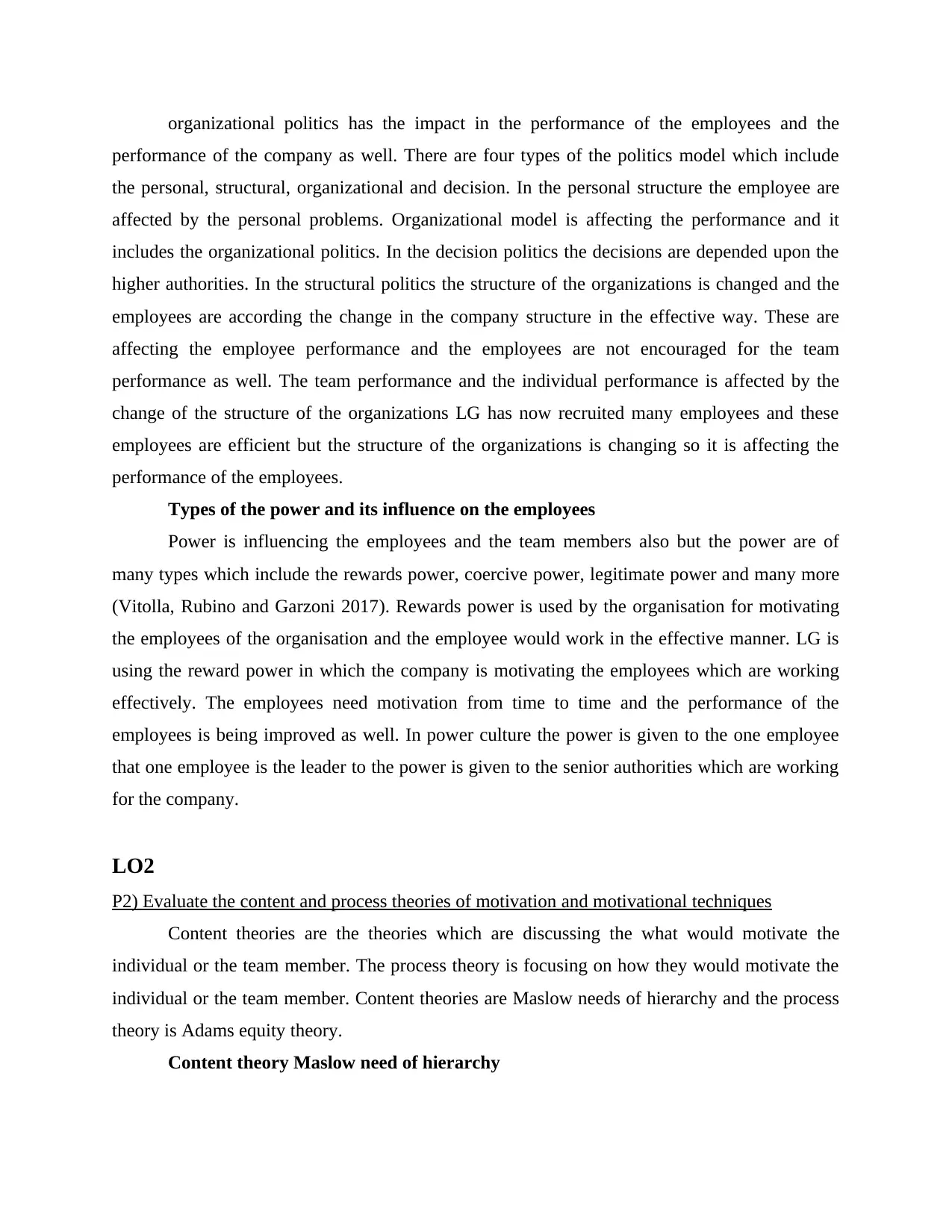
organizational politics has the impact in the performance of the employees and the
performance of the company as well. There are four types of the politics model which include
the personal, structural, organizational and decision. In the personal structure the employee are
affected by the personal problems. Organizational model is affecting the performance and it
includes the organizational politics. In the decision politics the decisions are depended upon the
higher authorities. In the structural politics the structure of the organizations is changed and the
employees are according the change in the company structure in the effective way. These are
affecting the employee performance and the employees are not encouraged for the team
performance as well. The team performance and the individual performance is affected by the
change of the structure of the organizations LG has now recruited many employees and these
employees are efficient but the structure of the organizations is changing so it is affecting the
performance of the employees.
Types of the power and its influence on the employees
Power is influencing the employees and the team members also but the power are of
many types which include the rewards power, coercive power, legitimate power and many more
(Vitolla, Rubino and Garzoni 2017). Rewards power is used by the organisation for motivating
the employees of the organisation and the employee would work in the effective manner. LG is
using the reward power in which the company is motivating the employees which are working
effectively. The employees need motivation from time to time and the performance of the
employees is being improved as well. In power culture the power is given to the one employee
that one employee is the leader to the power is given to the senior authorities which are working
for the company.
LO2
P2) Evaluate the content and process theories of motivation and motivational techniques
Content theories are the theories which are discussing the what would motivate the
individual or the team member. The process theory is focusing on how they would motivate the
individual or the team member. Content theories are Maslow needs of hierarchy and the process
theory is Adams equity theory.
Content theory Maslow need of hierarchy
performance of the company as well. There are four types of the politics model which include
the personal, structural, organizational and decision. In the personal structure the employee are
affected by the personal problems. Organizational model is affecting the performance and it
includes the organizational politics. In the decision politics the decisions are depended upon the
higher authorities. In the structural politics the structure of the organizations is changed and the
employees are according the change in the company structure in the effective way. These are
affecting the employee performance and the employees are not encouraged for the team
performance as well. The team performance and the individual performance is affected by the
change of the structure of the organizations LG has now recruited many employees and these
employees are efficient but the structure of the organizations is changing so it is affecting the
performance of the employees.
Types of the power and its influence on the employees
Power is influencing the employees and the team members also but the power are of
many types which include the rewards power, coercive power, legitimate power and many more
(Vitolla, Rubino and Garzoni 2017). Rewards power is used by the organisation for motivating
the employees of the organisation and the employee would work in the effective manner. LG is
using the reward power in which the company is motivating the employees which are working
effectively. The employees need motivation from time to time and the performance of the
employees is being improved as well. In power culture the power is given to the one employee
that one employee is the leader to the power is given to the senior authorities which are working
for the company.
LO2
P2) Evaluate the content and process theories of motivation and motivational techniques
Content theories are the theories which are discussing the what would motivate the
individual or the team member. The process theory is focusing on how they would motivate the
individual or the team member. Content theories are Maslow needs of hierarchy and the process
theory is Adams equity theory.
Content theory Maslow need of hierarchy
Paraphrase This Document
Need a fresh take? Get an instant paraphrase of this document with our AI Paraphraser
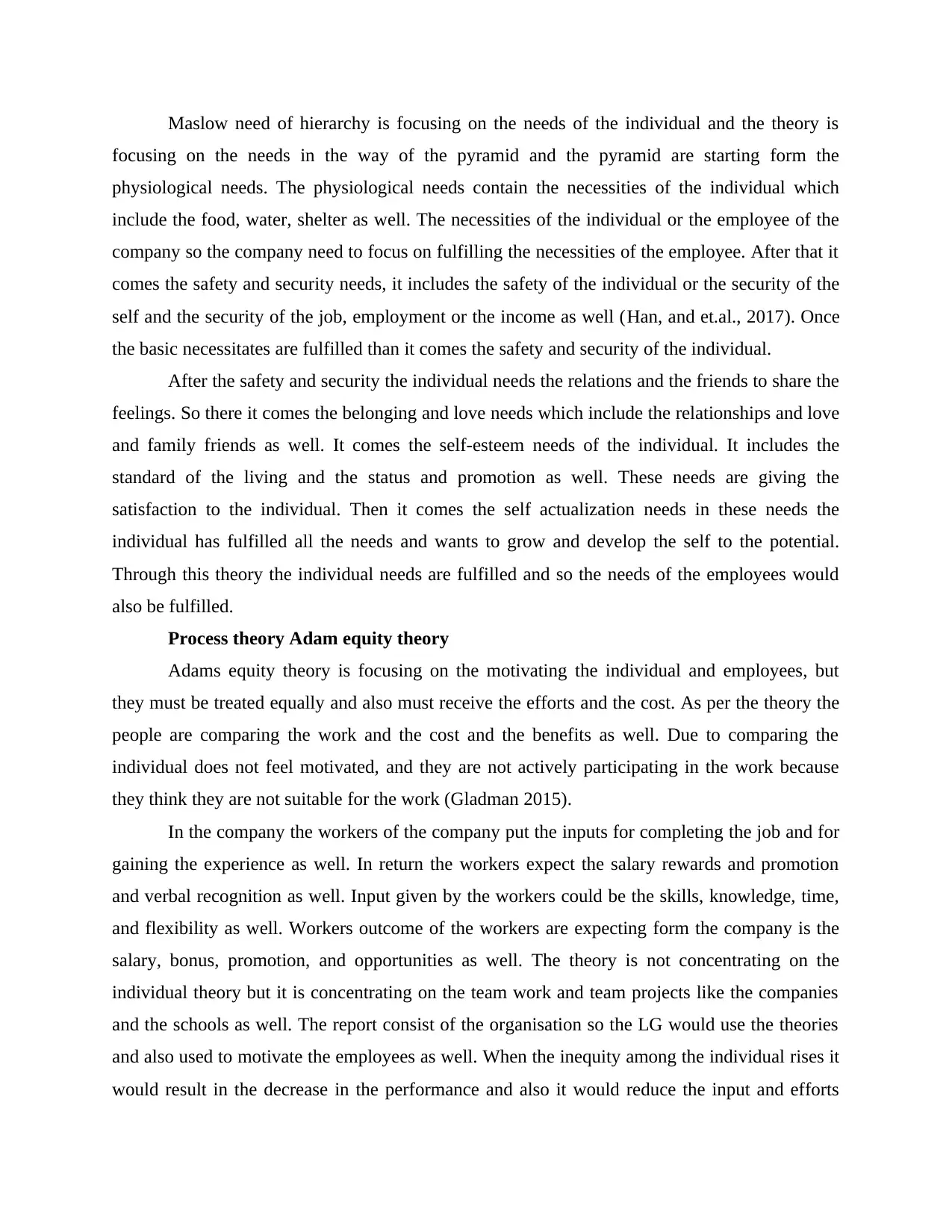
Maslow need of hierarchy is focusing on the needs of the individual and the theory is
focusing on the needs in the way of the pyramid and the pyramid are starting form the
physiological needs. The physiological needs contain the necessities of the individual which
include the food, water, shelter as well. The necessities of the individual or the employee of the
company so the company need to focus on fulfilling the necessities of the employee. After that it
comes the safety and security needs, it includes the safety of the individual or the security of the
self and the security of the job, employment or the income as well (Han, and et.al., 2017). Once
the basic necessitates are fulfilled than it comes the safety and security of the individual.
After the safety and security the individual needs the relations and the friends to share the
feelings. So there it comes the belonging and love needs which include the relationships and love
and family friends as well. It comes the self-esteem needs of the individual. It includes the
standard of the living and the status and promotion as well. These needs are giving the
satisfaction to the individual. Then it comes the self actualization needs in these needs the
individual has fulfilled all the needs and wants to grow and develop the self to the potential.
Through this theory the individual needs are fulfilled and so the needs of the employees would
also be fulfilled.
Process theory Adam equity theory
Adams equity theory is focusing on the motivating the individual and employees, but
they must be treated equally and also must receive the efforts and the cost. As per the theory the
people are comparing the work and the cost and the benefits as well. Due to comparing the
individual does not feel motivated, and they are not actively participating in the work because
they think they are not suitable for the work (Gladman 2015).
In the company the workers of the company put the inputs for completing the job and for
gaining the experience as well. In return the workers expect the salary rewards and promotion
and verbal recognition as well. Input given by the workers could be the skills, knowledge, time,
and flexibility as well. Workers outcome of the workers are expecting form the company is the
salary, bonus, promotion, and opportunities as well. The theory is not concentrating on the
individual theory but it is concentrating on the team work and team projects like the companies
and the schools as well. The report consist of the organisation so the LG would use the theories
and also used to motivate the employees as well. When the inequity among the individual rises it
would result in the decrease in the performance and also it would reduce the input and efforts
focusing on the needs in the way of the pyramid and the pyramid are starting form the
physiological needs. The physiological needs contain the necessities of the individual which
include the food, water, shelter as well. The necessities of the individual or the employee of the
company so the company need to focus on fulfilling the necessities of the employee. After that it
comes the safety and security needs, it includes the safety of the individual or the security of the
self and the security of the job, employment or the income as well (Han, and et.al., 2017). Once
the basic necessitates are fulfilled than it comes the safety and security of the individual.
After the safety and security the individual needs the relations and the friends to share the
feelings. So there it comes the belonging and love needs which include the relationships and love
and family friends as well. It comes the self-esteem needs of the individual. It includes the
standard of the living and the status and promotion as well. These needs are giving the
satisfaction to the individual. Then it comes the self actualization needs in these needs the
individual has fulfilled all the needs and wants to grow and develop the self to the potential.
Through this theory the individual needs are fulfilled and so the needs of the employees would
also be fulfilled.
Process theory Adam equity theory
Adams equity theory is focusing on the motivating the individual and employees, but
they must be treated equally and also must receive the efforts and the cost. As per the theory the
people are comparing the work and the cost and the benefits as well. Due to comparing the
individual does not feel motivated, and they are not actively participating in the work because
they think they are not suitable for the work (Gladman 2015).
In the company the workers of the company put the inputs for completing the job and for
gaining the experience as well. In return the workers expect the salary rewards and promotion
and verbal recognition as well. Input given by the workers could be the skills, knowledge, time,
and flexibility as well. Workers outcome of the workers are expecting form the company is the
salary, bonus, promotion, and opportunities as well. The theory is not concentrating on the
individual theory but it is concentrating on the team work and team projects like the companies
and the schools as well. The report consist of the organisation so the LG would use the theories
and also used to motivate the employees as well. When the inequity among the individual rises it
would result in the decrease in the performance and also it would reduce the input and efforts
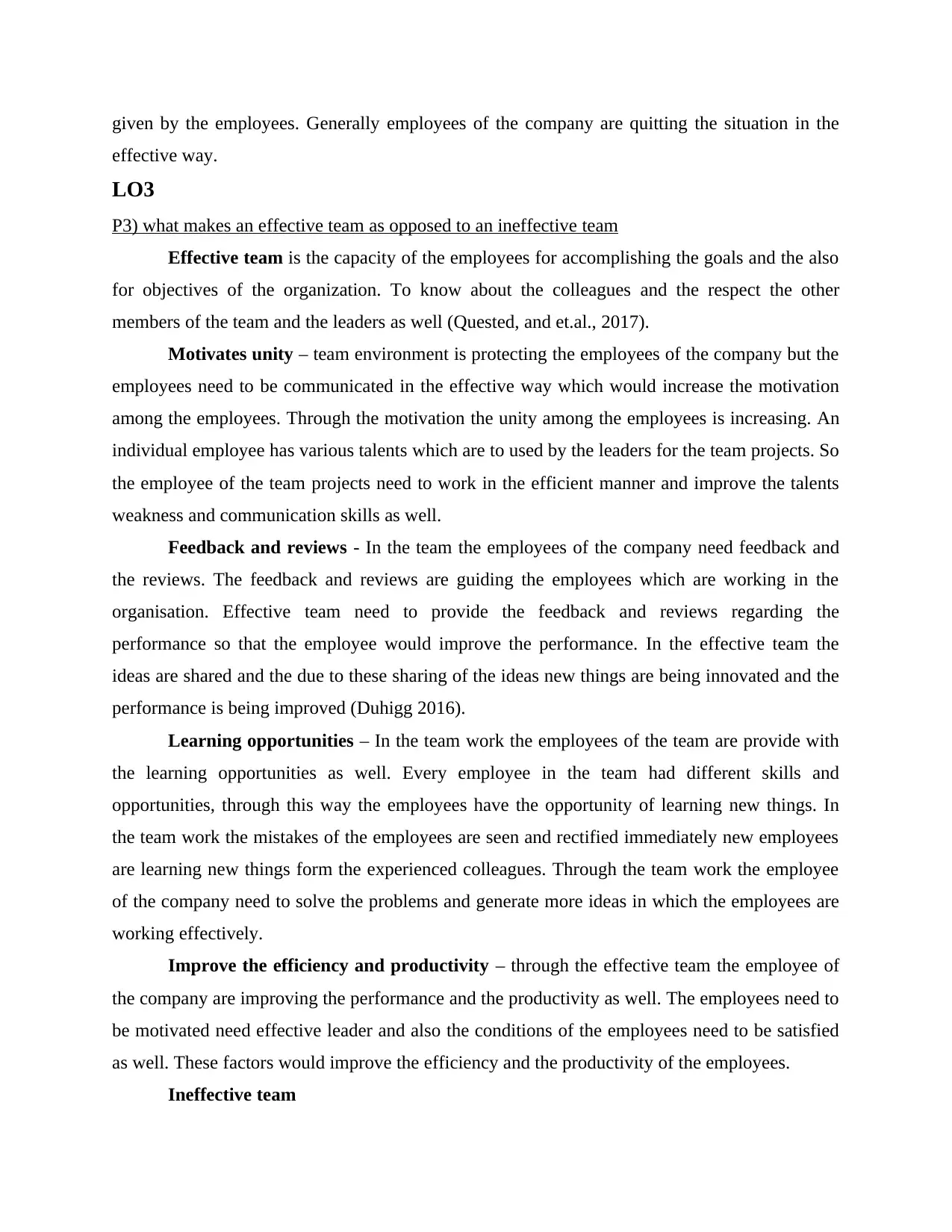
given by the employees. Generally employees of the company are quitting the situation in the
effective way.
LO3
P3) what makes an effective team as opposed to an ineffective team
Effective team is the capacity of the employees for accomplishing the goals and the also
for objectives of the organization. To know about the colleagues and the respect the other
members of the team and the leaders as well (Quested, and et.al., 2017).
Motivates unity – team environment is protecting the employees of the company but the
employees need to be communicated in the effective way which would increase the motivation
among the employees. Through the motivation the unity among the employees is increasing. An
individual employee has various talents which are to used by the leaders for the team projects. So
the employee of the team projects need to work in the efficient manner and improve the talents
weakness and communication skills as well.
Feedback and reviews - In the team the employees of the company need feedback and
the reviews. The feedback and reviews are guiding the employees which are working in the
organisation. Effective team need to provide the feedback and reviews regarding the
performance so that the employee would improve the performance. In the effective team the
ideas are shared and the due to these sharing of the ideas new things are being innovated and the
performance is being improved (Duhigg 2016).
Learning opportunities – In the team work the employees of the team are provide with
the learning opportunities as well. Every employee in the team had different skills and
opportunities, through this way the employees have the opportunity of learning new things. In
the team work the mistakes of the employees are seen and rectified immediately new employees
are learning new things form the experienced colleagues. Through the team work the employee
of the company need to solve the problems and generate more ideas in which the employees are
working effectively.
Improve the efficiency and productivity – through the effective team the employee of
the company are improving the performance and the productivity as well. The employees need to
be motivated need effective leader and also the conditions of the employees need to be satisfied
as well. These factors would improve the efficiency and the productivity of the employees.
Ineffective team
effective way.
LO3
P3) what makes an effective team as opposed to an ineffective team
Effective team is the capacity of the employees for accomplishing the goals and the also
for objectives of the organization. To know about the colleagues and the respect the other
members of the team and the leaders as well (Quested, and et.al., 2017).
Motivates unity – team environment is protecting the employees of the company but the
employees need to be communicated in the effective way which would increase the motivation
among the employees. Through the motivation the unity among the employees is increasing. An
individual employee has various talents which are to used by the leaders for the team projects. So
the employee of the team projects need to work in the efficient manner and improve the talents
weakness and communication skills as well.
Feedback and reviews - In the team the employees of the company need feedback and
the reviews. The feedback and reviews are guiding the employees which are working in the
organisation. Effective team need to provide the feedback and reviews regarding the
performance so that the employee would improve the performance. In the effective team the
ideas are shared and the due to these sharing of the ideas new things are being innovated and the
performance is being improved (Duhigg 2016).
Learning opportunities – In the team work the employees of the team are provide with
the learning opportunities as well. Every employee in the team had different skills and
opportunities, through this way the employees have the opportunity of learning new things. In
the team work the mistakes of the employees are seen and rectified immediately new employees
are learning new things form the experienced colleagues. Through the team work the employee
of the company need to solve the problems and generate more ideas in which the employees are
working effectively.
Improve the efficiency and productivity – through the effective team the employee of
the company are improving the performance and the productivity as well. The employees need to
be motivated need effective leader and also the conditions of the employees need to be satisfied
as well. These factors would improve the efficiency and the productivity of the employees.
Ineffective team
⊘ This is a preview!⊘
Do you want full access?
Subscribe today to unlock all pages.

Trusted by 1+ million students worldwide
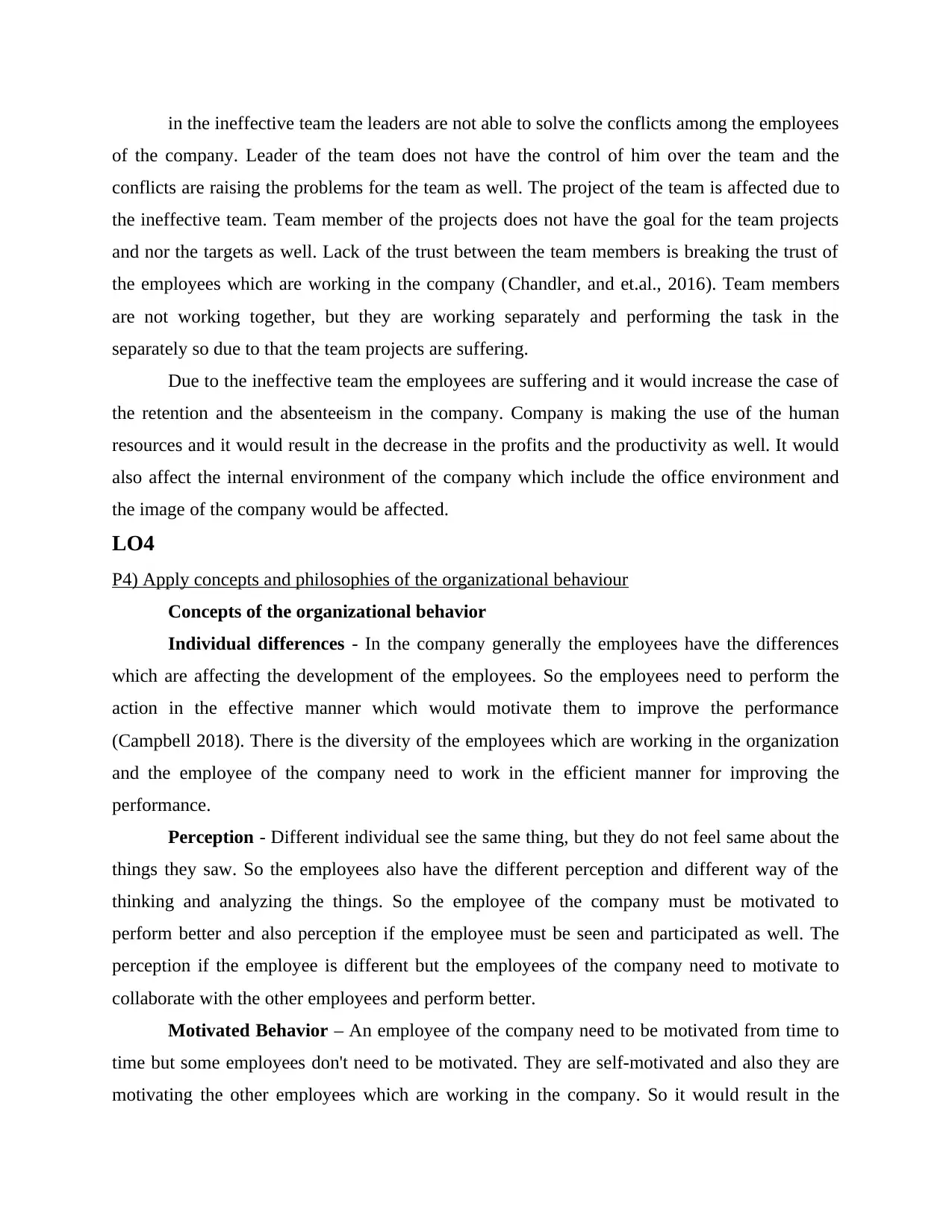
in the ineffective team the leaders are not able to solve the conflicts among the employees
of the company. Leader of the team does not have the control of him over the team and the
conflicts are raising the problems for the team as well. The project of the team is affected due to
the ineffective team. Team member of the projects does not have the goal for the team projects
and nor the targets as well. Lack of the trust between the team members is breaking the trust of
the employees which are working in the company (Chandler, and et.al., 2016). Team members
are not working together, but they are working separately and performing the task in the
separately so due to that the team projects are suffering.
Due to the ineffective team the employees are suffering and it would increase the case of
the retention and the absenteeism in the company. Company is making the use of the human
resources and it would result in the decrease in the profits and the productivity as well. It would
also affect the internal environment of the company which include the office environment and
the image of the company would be affected.
LO4
P4) Apply concepts and philosophies of the organizational behaviour
Concepts of the organizational behavior
Individual differences - In the company generally the employees have the differences
which are affecting the development of the employees. So the employees need to perform the
action in the effective manner which would motivate them to improve the performance
(Campbell 2018). There is the diversity of the employees which are working in the organization
and the employee of the company need to work in the efficient manner for improving the
performance.
Perception - Different individual see the same thing, but they do not feel same about the
things they saw. So the employees also have the different perception and different way of the
thinking and analyzing the things. So the employee of the company must be motivated to
perform better and also perception if the employee must be seen and participated as well. The
perception if the employee is different but the employees of the company need to motivate to
collaborate with the other employees and perform better.
Motivated Behavior – An employee of the company need to be motivated from time to
time but some employees don't need to be motivated. They are self-motivated and also they are
motivating the other employees which are working in the company. So it would result in the
of the company. Leader of the team does not have the control of him over the team and the
conflicts are raising the problems for the team as well. The project of the team is affected due to
the ineffective team. Team member of the projects does not have the goal for the team projects
and nor the targets as well. Lack of the trust between the team members is breaking the trust of
the employees which are working in the company (Chandler, and et.al., 2016). Team members
are not working together, but they are working separately and performing the task in the
separately so due to that the team projects are suffering.
Due to the ineffective team the employees are suffering and it would increase the case of
the retention and the absenteeism in the company. Company is making the use of the human
resources and it would result in the decrease in the profits and the productivity as well. It would
also affect the internal environment of the company which include the office environment and
the image of the company would be affected.
LO4
P4) Apply concepts and philosophies of the organizational behaviour
Concepts of the organizational behavior
Individual differences - In the company generally the employees have the differences
which are affecting the development of the employees. So the employees need to perform the
action in the effective manner which would motivate them to improve the performance
(Campbell 2018). There is the diversity of the employees which are working in the organization
and the employee of the company need to work in the efficient manner for improving the
performance.
Perception - Different individual see the same thing, but they do not feel same about the
things they saw. So the employees also have the different perception and different way of the
thinking and analyzing the things. So the employee of the company must be motivated to
perform better and also perception if the employee must be seen and participated as well. The
perception if the employee is different but the employees of the company need to motivate to
collaborate with the other employees and perform better.
Motivated Behavior – An employee of the company need to be motivated from time to
time but some employees don't need to be motivated. They are self-motivated and also they are
motivating the other employees which are working in the company. So it would result in the
Paraphrase This Document
Need a fresh take? Get an instant paraphrase of this document with our AI Paraphraser
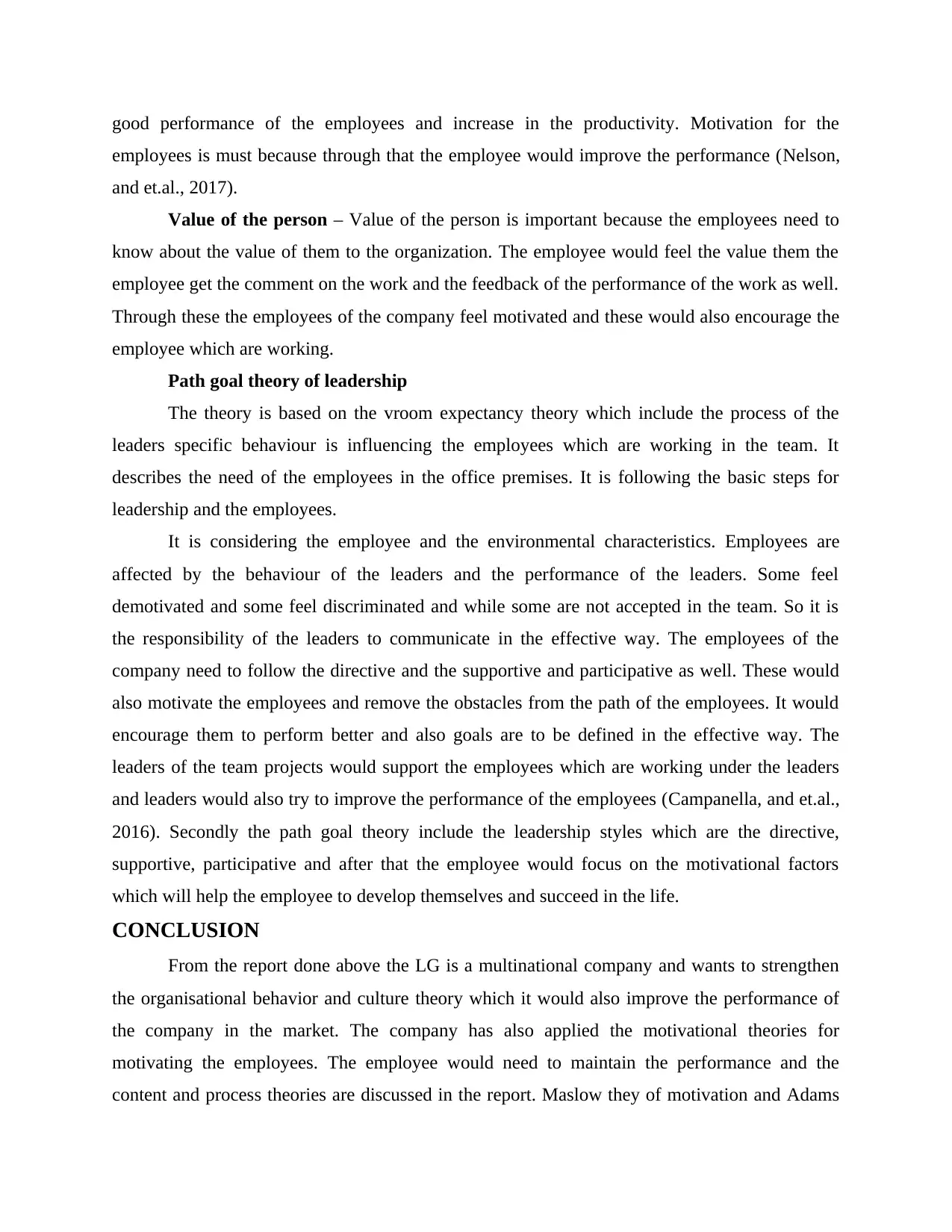
good performance of the employees and increase in the productivity. Motivation for the
employees is must because through that the employee would improve the performance (Nelson,
and et.al., 2017).
Value of the person – Value of the person is important because the employees need to
know about the value of them to the organization. The employee would feel the value them the
employee get the comment on the work and the feedback of the performance of the work as well.
Through these the employees of the company feel motivated and these would also encourage the
employee which are working.
Path goal theory of leadership
The theory is based on the vroom expectancy theory which include the process of the
leaders specific behaviour is influencing the employees which are working in the team. It
describes the need of the employees in the office premises. It is following the basic steps for
leadership and the employees.
It is considering the employee and the environmental characteristics. Employees are
affected by the behaviour of the leaders and the performance of the leaders. Some feel
demotivated and some feel discriminated and while some are not accepted in the team. So it is
the responsibility of the leaders to communicate in the effective way. The employees of the
company need to follow the directive and the supportive and participative as well. These would
also motivate the employees and remove the obstacles from the path of the employees. It would
encourage them to perform better and also goals are to be defined in the effective way. The
leaders of the team projects would support the employees which are working under the leaders
and leaders would also try to improve the performance of the employees (Campanella, and et.al.,
2016). Secondly the path goal theory include the leadership styles which are the directive,
supportive, participative and after that the employee would focus on the motivational factors
which will help the employee to develop themselves and succeed in the life.
CONCLUSION
From the report done above the LG is a multinational company and wants to strengthen
the organisational behavior and culture theory which it would also improve the performance of
the company in the market. The company has also applied the motivational theories for
motivating the employees. The employee would need to maintain the performance and the
content and process theories are discussed in the report. Maslow they of motivation and Adams
employees is must because through that the employee would improve the performance (Nelson,
and et.al., 2017).
Value of the person – Value of the person is important because the employees need to
know about the value of them to the organization. The employee would feel the value them the
employee get the comment on the work and the feedback of the performance of the work as well.
Through these the employees of the company feel motivated and these would also encourage the
employee which are working.
Path goal theory of leadership
The theory is based on the vroom expectancy theory which include the process of the
leaders specific behaviour is influencing the employees which are working in the team. It
describes the need of the employees in the office premises. It is following the basic steps for
leadership and the employees.
It is considering the employee and the environmental characteristics. Employees are
affected by the behaviour of the leaders and the performance of the leaders. Some feel
demotivated and some feel discriminated and while some are not accepted in the team. So it is
the responsibility of the leaders to communicate in the effective way. The employees of the
company need to follow the directive and the supportive and participative as well. These would
also motivate the employees and remove the obstacles from the path of the employees. It would
encourage them to perform better and also goals are to be defined in the effective way. The
leaders of the team projects would support the employees which are working under the leaders
and leaders would also try to improve the performance of the employees (Campanella, and et.al.,
2016). Secondly the path goal theory include the leadership styles which are the directive,
supportive, participative and after that the employee would focus on the motivational factors
which will help the employee to develop themselves and succeed in the life.
CONCLUSION
From the report done above the LG is a multinational company and wants to strengthen
the organisational behavior and culture theory which it would also improve the performance of
the company in the market. The company has also applied the motivational theories for
motivating the employees. The employee would need to maintain the performance and the
content and process theories are discussed in the report. Maslow they of motivation and Adams
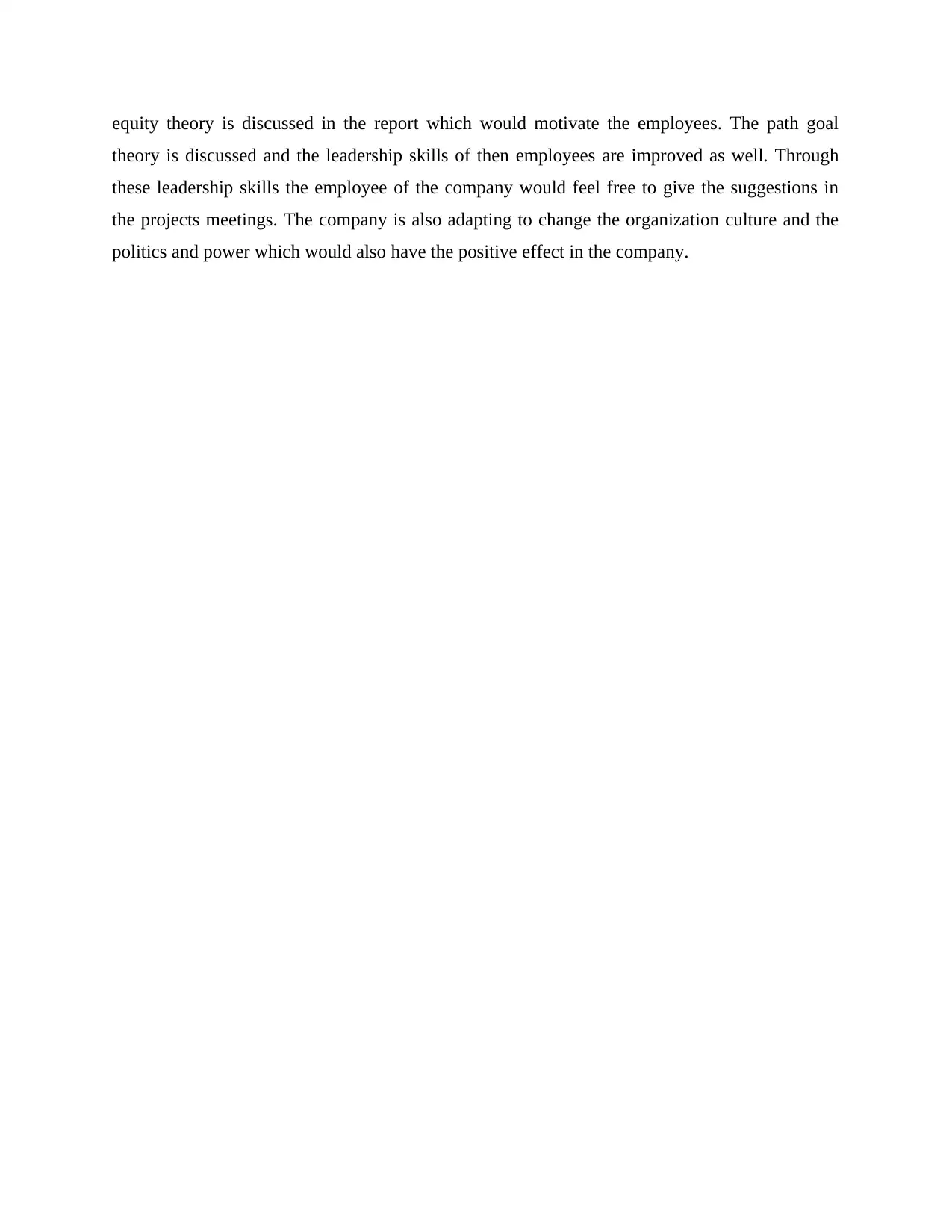
equity theory is discussed in the report which would motivate the employees. The path goal
theory is discussed and the leadership skills of then employees are improved as well. Through
these leadership skills the employee of the company would feel free to give the suggestions in
the projects meetings. The company is also adapting to change the organization culture and the
politics and power which would also have the positive effect in the company.
theory is discussed and the leadership skills of then employees are improved as well. Through
these leadership skills the employee of the company would feel free to give the suggestions in
the projects meetings. The company is also adapting to change the organization culture and the
politics and power which would also have the positive effect in the company.
⊘ This is a preview!⊘
Do you want full access?
Subscribe today to unlock all pages.

Trusted by 1+ million students worldwide

Paraphrase This Document
Need a fresh take? Get an instant paraphrase of this document with our AI Paraphraser
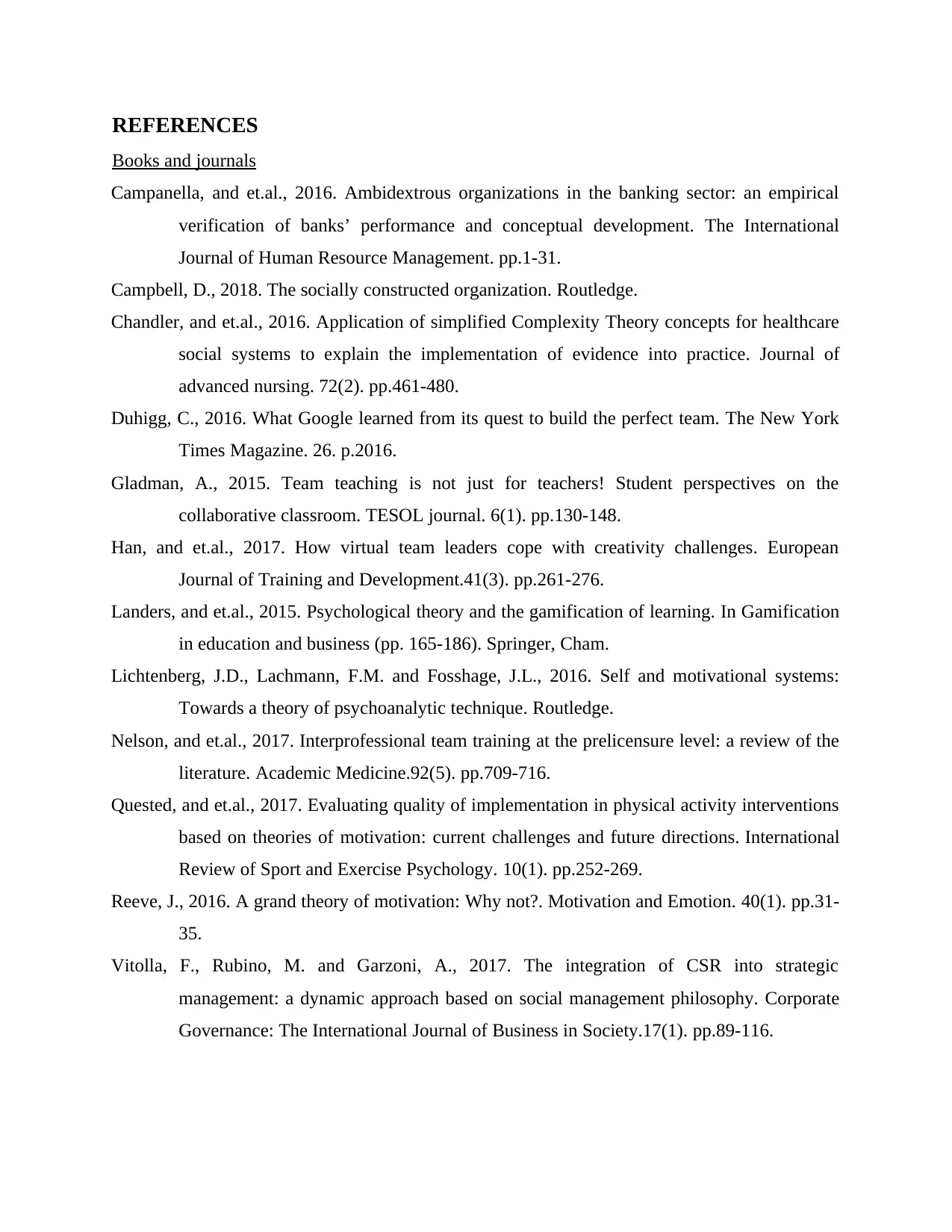
REFERENCES
Books and journals
Campanella, and et.al., 2016. Ambidextrous organizations in the banking sector: an empirical
verification of banks’ performance and conceptual development. The International
Journal of Human Resource Management. pp.1-31.
Campbell, D., 2018. The socially constructed organization. Routledge.
Chandler, and et.al., 2016. Application of simplified Complexity Theory concepts for healthcare
social systems to explain the implementation of evidence into practice. Journal of
advanced nursing. 72(2). pp.461-480.
Duhigg, C., 2016. What Google learned from its quest to build the perfect team. The New York
Times Magazine. 26. p.2016.
Gladman, A., 2015. Team teaching is not just for teachers! Student perspectives on the
collaborative classroom. TESOL journal. 6(1). pp.130-148.
Han, and et.al., 2017. How virtual team leaders cope with creativity challenges. European
Journal of Training and Development.41(3). pp.261-276.
Landers, and et.al., 2015. Psychological theory and the gamification of learning. In Gamification
in education and business (pp. 165-186). Springer, Cham.
Lichtenberg, J.D., Lachmann, F.M. and Fosshage, J.L., 2016. Self and motivational systems:
Towards a theory of psychoanalytic technique. Routledge.
Nelson, and et.al., 2017. Interprofessional team training at the prelicensure level: a review of the
literature. Academic Medicine.92(5). pp.709-716.
Quested, and et.al., 2017. Evaluating quality of implementation in physical activity interventions
based on theories of motivation: current challenges and future directions. International
Review of Sport and Exercise Psychology. 10(1). pp.252-269.
Reeve, J., 2016. A grand theory of motivation: Why not?. Motivation and Emotion. 40(1). pp.31-
35.
Vitolla, F., Rubino, M. and Garzoni, A., 2017. The integration of CSR into strategic
management: a dynamic approach based on social management philosophy. Corporate
Governance: The International Journal of Business in Society.17(1). pp.89-116.
Books and journals
Campanella, and et.al., 2016. Ambidextrous organizations in the banking sector: an empirical
verification of banks’ performance and conceptual development. The International
Journal of Human Resource Management. pp.1-31.
Campbell, D., 2018. The socially constructed organization. Routledge.
Chandler, and et.al., 2016. Application of simplified Complexity Theory concepts for healthcare
social systems to explain the implementation of evidence into practice. Journal of
advanced nursing. 72(2). pp.461-480.
Duhigg, C., 2016. What Google learned from its quest to build the perfect team. The New York
Times Magazine. 26. p.2016.
Gladman, A., 2015. Team teaching is not just for teachers! Student perspectives on the
collaborative classroom. TESOL journal. 6(1). pp.130-148.
Han, and et.al., 2017. How virtual team leaders cope with creativity challenges. European
Journal of Training and Development.41(3). pp.261-276.
Landers, and et.al., 2015. Psychological theory and the gamification of learning. In Gamification
in education and business (pp. 165-186). Springer, Cham.
Lichtenberg, J.D., Lachmann, F.M. and Fosshage, J.L., 2016. Self and motivational systems:
Towards a theory of psychoanalytic technique. Routledge.
Nelson, and et.al., 2017. Interprofessional team training at the prelicensure level: a review of the
literature. Academic Medicine.92(5). pp.709-716.
Quested, and et.al., 2017. Evaluating quality of implementation in physical activity interventions
based on theories of motivation: current challenges and future directions. International
Review of Sport and Exercise Psychology. 10(1). pp.252-269.
Reeve, J., 2016. A grand theory of motivation: Why not?. Motivation and Emotion. 40(1). pp.31-
35.
Vitolla, F., Rubino, M. and Garzoni, A., 2017. The integration of CSR into strategic
management: a dynamic approach based on social management philosophy. Corporate
Governance: The International Journal of Business in Society.17(1). pp.89-116.
1 out of 11
Related Documents
Your All-in-One AI-Powered Toolkit for Academic Success.
+13062052269
info@desklib.com
Available 24*7 on WhatsApp / Email
![[object Object]](/_next/static/media/star-bottom.7253800d.svg)
Unlock your academic potential
Copyright © 2020–2025 A2Z Services. All Rights Reserved. Developed and managed by ZUCOL.





